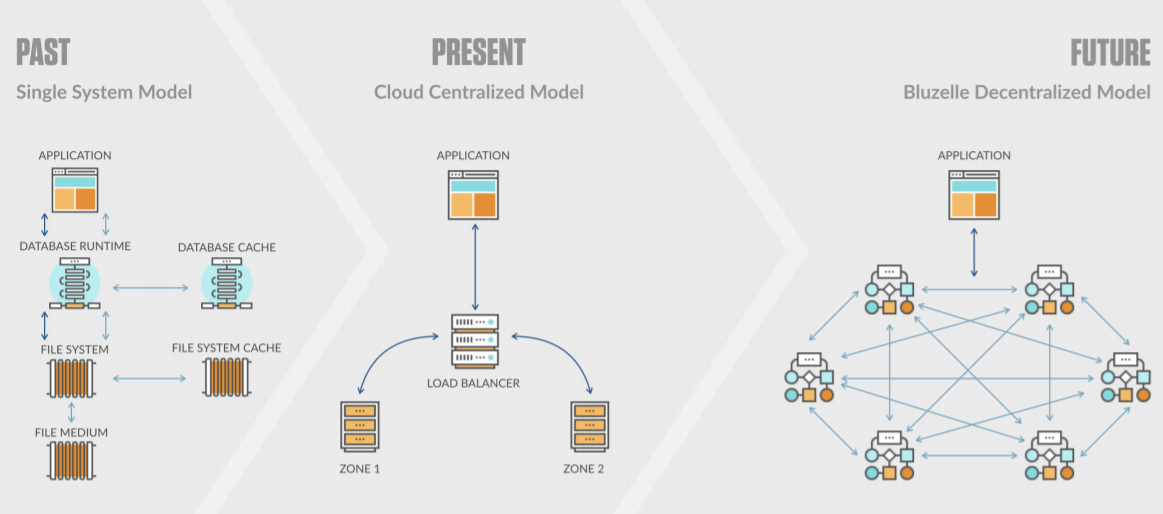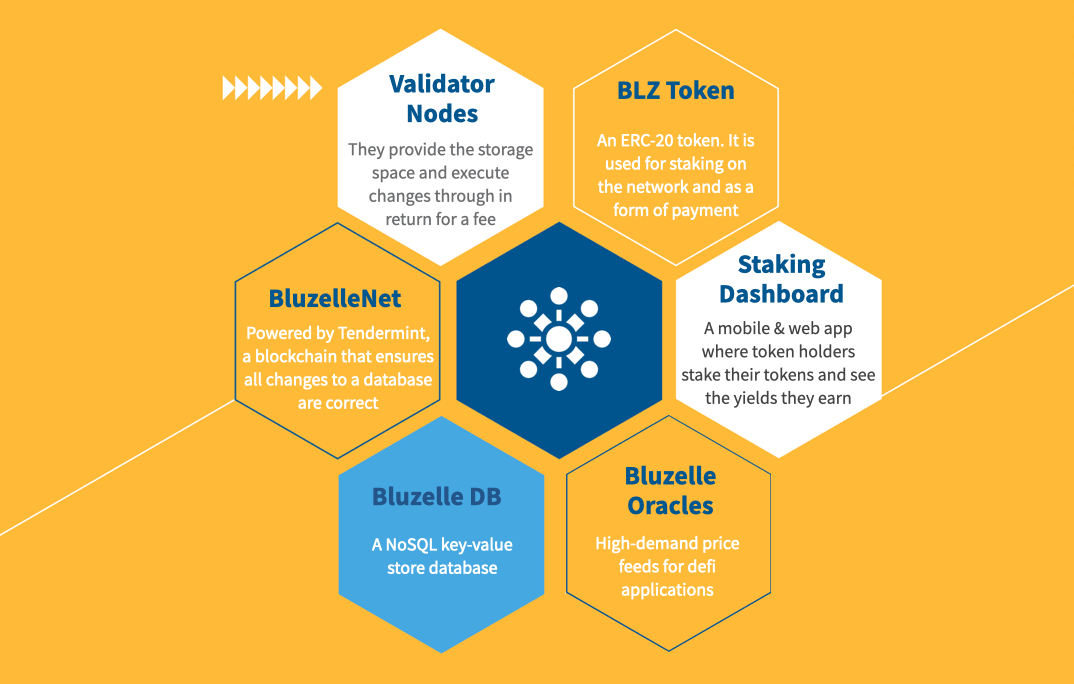February 3, 2021,marked an important event for dApps to realize their full potential with the release of Bluzelle mainet. Bluzelle is a decentralized, on-demand, and scalable database service for dApps. Designed for storing massive amounts of data exchanged by dApps, it is a decentralized alternative to the Oracle databases.
The blockchains such as Ethereum enable the deployment of applications in a decentralized setting. But these platforms are not designed for the data storage and management requirements of applications. Storing large amounts of data on a blockchain like Ethereum is slow and extremely expensive. The high Ethereum gas price forces dApps to store their data in some centralized services, meaning they aren’t truly decentralized and are susceptible to failures. Whereas, Bluzelle is a proof of stake decentralized database for Web3, powered by Cosmos and its BFT technology Tendermint. It can be used for dApp developed on any blockchain.
You can check the status of the mainnet here. It has the capability to process 10,000 transactions per second and interoperate across any chain. Protecting businesses from data breaches, network failure, and performance issues, Bluzelle effectively serves as an “Airbnb of databases,” with developers paying for storage space and read/write access to the decentralized database.
Token Economy
Bluzelle is powered by its native token BNT, and an Ethereum-based ERC20 token, BLT. Out of a total token supply of 500M, 165M tokens have been sold. Currently trading at $0.145, BLT tokens are available for sale on Binance and Huobi exchanges. Just a few days after its launch, the coin is trending on Coingecko, a famous cryptocurrency ranking website.
Timeline
Bluzelle has successfully launched two incentivized testnets, Swarm of Duty 1 in July 2020 and Swarm of Duty 2 in December 2020. Notably, Bluzelle recorded 200+ validators participating in these testnets.
The release of the mainnet follows the success of the soft mainnet, which was launched back in August 2020. It has attracted extensive participation from the Bluzelle community.
Currently, Bluzelle is looking forward to its Polkadot integration, making Bluzelle interoperable with a whole universe of other blockchains. Bluzelle is bringing decentralized database capabilities to projects building on Polkadot’s Substrate framework. Bluzelle’s database services will become available on both the Polkadot mainnet and its test-network counterpart, Kusama.
Bluzelle’s Comparison with Other Databases

Source: https://s3.amazonaws.com/bluzelle-craft-private-storage/Bluzelle-Token-Sale-White-Paper-1.5.pdf?mtime=20180613161914
Advantages over earlier and present Database systems:
- No points of failure; data distributed among multiple nodes of a swarm that are geographically dispersed across the globe. Thus it is Immune to local outages.
- Scales efficiently; both horizontally and vertically by using swarms.
- Provides the highest privacy; employs cryptography and sharding techniques.
- Immutable data storage and leverages blockchain technology. Once data is saved, it is impossible to change that data.
- No performance limitations; reduces data latency by retrieving data from the nearest nodes on leaf swarm, and retrieving shards of data in parallel from different swarms that contain those shards. The protocol dynamically adjusts the number and location of nodes sharding the consumer’s data to meet performance metrics.
- No Intruders; use of consensus for any update to the network.
- Low cost; the vast majority of computer resources are provided by participant producers. So there are only a few data centers.
Users
Consumers: Customers of Bluzelle are software developers who are building decentralized applications and want to use the database to store off-chain data at a low cost. They spend Bluzelle tokens (BLZ) to store and retrieve data. Sends encrypted data.
To store data to Bluzelle, consumers need to sign a lease and specify the length of time that the data will persist. The lease is a cryptographic contractual agreement between the user of the database, and the blockchain itself, that guarantees that in return for the gas expended to create that data, the data will be stored securely and be highly available to the user for the length of time of that lease.
Consumers store encrypted data on the Bluzelle network and pay for its use by using gas. They pay for “Gas per DayByte.” The “DayByte” refers to one byte being stored for one day. So, “Gas Per DayByte” refers to the number of gas units for each DayByte.
Validators: These are the people and businesses with spare disk capacity to rent out their space and earn extra income. Compare it to AirBnB but instead of physical space it is digital. They provide resources to the network in return for Bluzelle tokens.
To be a validator, users are required to put a proportional stake of tokens to ensure high-quality service. This stake serves as a requirement for participation and as a strong economic deterrent from bad behavior.
Bluzelle Architecture
With Bluzelle, the data is stored on a network of 13 or more nodes. Each such network is called a database zone, and all zones are synced together. No node is a leader, ensuring that if a node is offline, the data is still available as all the other nodes have a copy. Additionally, because all the nodes are synced with a consensus engine, no changes can be made to the database unless 2/3rd of the nodes agree. This ensures that the data is censorship-resistant and tamper-proof.
Bluzelle consists of the following components that work together:

Source: https://blog.bluzelle.com/introducing-bluzelle-oracles-6b06c547d830
- Database Engine – A NoSQL key-value store database. It is built using the Cosmos SDK.
- BFT Consensus Engine – Powered by Tendermint, this component ensures all the nodes remain in sync.
- Nodes – The core foundation of Bluzelle is operated by nodes provided by the public community. They provide the storage space and execute changes through consensus in return for a fee.
- Bluzelle token (BLZ) – An Ethereum based ERC-20 token is easily obtained outside the Bluzelle network. It is used to gain entry into Bluzelle where it is converted into the Bluzelle Native Token (BNT).
- Bluzelle Studio – an interactive web app that allows developers to work with the database
Data Storage
Bluzelle DB comprises multiple swarms. A swarm is a large group of nodes that work together to store and manage data.
It stores data using sharding. A logical shard is the smallest unit in Bluzelle and contains individual units of data that all share the same partition key. A partition key is a unique identifier that allows the shard to be accessed for the retrieval of information. In Bluzelle, partition keys allow the dApp to store and retrieve data from the correctly identified leaf swarm efficiently.
In Bluzelle, groups of logical shards are stored on leaf swarms, and it is the amalgamation of these leaf swarms that makes up the entirety of the Bluzelle database.
The DB is different from blockchain as only the nodes within the leaf swarm delegated to that data replicate it. Partial replication exists because only one swarm amongst all the swarms in the network replicates a given piece of data.
Consensus Mechanism
Bluzelle deals with consensus differently from blockchains, doing away with any concept of a network-wide universal state. There is no need for a single state for the whole network, so Bluzelle applies the consensus model on a swarming level, ensuring that leaf swarms of nodes storing data shards are each reaching localized consensus. Any node in that leaf swarm can accurately service requests pertaining to that data.
Bluzelle Integrations
BluzelleDB can be easily accessed and integrated into dApp code by using different client libraries written in JS, Python, Go, Ruby, and so on. It is already being used by several developer teams keen to provide a database that can scale as needed, has maximum uptime, and is highly secure for their dApps.
RioChain, a Parity Substrate-based blockchain, will utilize Bluzelle’s scalable and interoperable decentralized DB for off-chain storage of their DeFi data. MANTRA DAO, which is a DeFi platform focusing on staking, lending, and governance, is built on Parity Substrate for the Polkadot ecosystem. MANTRA DAO will integrate Bluzelle’s decentralized database into their future products.
Phala Network, a Polkadot-based project focused on data privacy-preserving protocol, has announced a partnership with Bluzelle. They have chosen Bluzelle’s decentralized database as one of their off-chain data storage solutions for their main product, Web3 Analytics.
Other integrations involve providing a decentralized data stack for Elrond, a blockchain platform. It has partnered with Bluzelle to provide applications built on the Elrond mainnet with a fully decentralized database layer.
A layer 2 scaling platform for Ethereum, Matic Network will be working with Bluzelle to enable developers to store their data in a decentralized manner. It will also be used by HedgeTrade, a leading social trading platform.
Bluzelle Oracles
Currently, companies operating in the decentralized finance space rely on oracles for real-time on-chain data. Most of them are supported by a centralized or semi-centralized oracle for critical external information. The need for oracles arises because blockchains do not have on-chain data saved in their ecosystems. To reference this data, this information is usually sourced from centralized crypto exchanges such as Binance and Coinbase.
An upcoming Bluzelle initiative, the Bluzelle Oracle service, will provide high demand price feeds for DeFi applications. Bluzelle Oracle will fetch data in short intervals and store it on Bluzelle DB. Every node has the same price stored that was validated by the whole network. It means DeFi applications can grab them quickly and aren’t constrained by congestion issues such as on Ethereum. Bluzelle Oracles has an on-demand historical price index. That enables applications to run statistical analysis that will generate warnings when a price point appears out of the norm.
Many blockchain applications integrated with Bluzelle Oracles to enable reliable real-time price feeds. Swingby’s Skybridge, a decentralized protocol for moving assets between blockchains like the Bitcoin network, Ethereum, and Binance Chain, has collaborated with Bluzelle.
Leading DeFi applications like Equilibrium, Tidal Finance, UniLend Finance, Stafi Protocol, TomoChain, and Reef Finance have partnered with Bluzelle Oracles to power their next generation of DeFi transactions.
Conclusion
Like other platforms on the blockchain, Bluzelle aims to provide a proper decentralized framework. Currently powered by just 15 validators, we will have to wait for its adoption by the emerging decentralized applications to realize its full potential.
 cryptoknowmics.com
cryptoknowmics.com